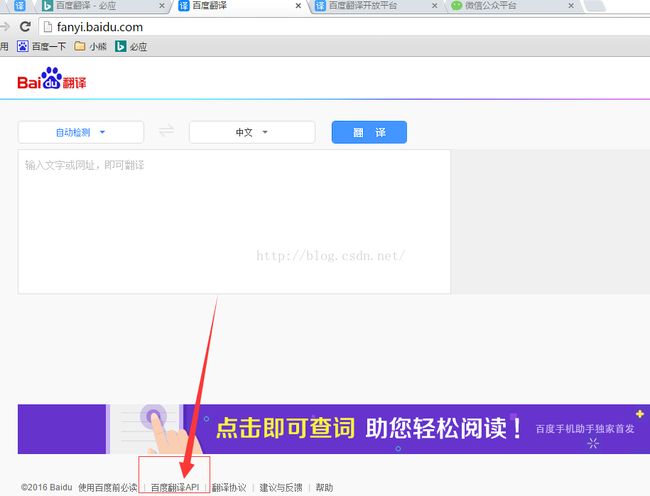详解Gson使用(五)实现百度翻译功能
项目地址:
Github : https://github.com/smileysx/GsonTestOschina:https://git.oschina.net/ysx_xx/GsonText
详解Gson使用(一)简单对象转化
http://blog.csdn.net/a249900679/article/details/51385913
详解Gson使用(二)带泛型的List转化
http://blog.csdn.net/a249900679/article/details/51386028
详解Gson使用(三)使用注解
http://blog.csdn.net/a249900679/article/details/51386509
http://blog.csdn.net/a249900679/article/details/51386660
详解Gson使用(五)实现百度翻译功能
http://blog.csdn.net/a249900679/article/details/51386727
前几篇介绍了Gson的使用,json数据都是自己定义的,现在来实战一下,就用百度翻译为例子。
要用百度翻译api,我们先要注册百度账号,然后注册成为开发者,获得appid跟秘钥等信息。
搜索百度翻译,点击百度翻译api

注册完成,在管理控制台->开发者信息页面就能看到appid跟秘钥,在后面会用到

接下来看看接入文档:

找到下面的签名生成方法:

根据方法生成sign的值,请求数据时用到。
下面有个拼接的例子:

Salt是随机数,可以自己生成一个随机数
知道请求方法后,我们就可以来写代码了:
拼接生成MD5字符串/**
* 进行MD5加密
*/
params.add(new BasicNameValuePair("sign", MD5Utils.md5(APPID + "apple" + "1234567890" + PASSWORD)));
Post请求发送数据:
HttpPost httpPost = new HttpPost(URL);
List<NameValuePair> params = new ArrayList<NameValuePair>();
params.add(new BasicNameValuePair("q", "apple"));
params.add(new BasicNameValuePair("from", "zh"));
params.add(new BasicNameValuePair("to", "en"));
params.add(new BasicNameValuePair("appid", APPID));
params.add(new BasicNameValuePair("salt", "1234567890"));
先把结果打印出来看看:

发现用from,to,trans_result字段,其中trans_result字段是一个数组,里面有src跟dst字段,我们就可以根据这些设计一个bean:
ResultBean.java
public class ResultBean {
private String from;
private String to;
private List<TransResultBean> trans_result;
public ResultBean(String from, String to, List<TransResultBean> trans_result) {
super();
this.from = from;
this.to = to;
this.trans_result = trans_result;
}
public String getFrom() {
return from;
}
public String getTo() {
return to;
}
public List<TransResultBean> getTransResult() {
return trans_result;
}
public void setFrom(String from) {
this.from = from;
}
public void setTo(String to) {
this.to = to;
}
public void setTransResult(List<TransResultBean> trans_result) {
this.trans_result = trans_result;
}
}
TransResultBean.java
public class TransResultBean {
private String src;
private String dst;
public TransResultBean(String src, String dst) {
super();
this.src = src;
this.dst = dst;
}
public String getSrc() {
return src;
}
public String getDst() {
return dst;
}
public void setSrc(String src) {
this.src = src;
}
public void setDst(String dst) {
this.dst = dst;
}
}
然后就可以开始解析了:

结果是这样:

完整代码:
public class MainActivity extends Activity implements OnClickListener {
/**
* 请求成功
*/
private final static int SUCCESS = 1;
/**
* 请求失败
*/
private final static int FAILE = 0;
/**
* 显示数据
*/
private TextView showText;
/**
* 发送按钮
*/
private Button send;
private Gson gson;
/**
* 请求地址
*/
private final static String URL = "http://api.fanyi.baidu.com/api/trans/vip/translate";
/**
* 百度翻译appid
*/
private final static String APPID = "你的appid";
/**
* 百度翻译秘钥
*/
private final static String PASSWORD = "你的秘钥";
@Override
protected void onCreate(Bundle savedInstanceState) {
super.onCreate(savedInstanceState);
setContentView(R.layout.activity_main);
initData();
}
private void initData() {
gson = new Gson();
showText = (TextView) findViewById(R.id.showtext);
send = (Button) findViewById(R.id.send);
send.setOnClickListener(this);
}
@Override
public void onClick(View v) {
switch (v.getId()) {
case R.id.send:
send();
break;
}
}
@SuppressLint("HandlerLeak")
private Handler mHandler = new Handler() {
public void handleMessage(Message msg) {
String response;
switch (msg.what) {
case SUCCESS:
Log.d("status", "success");
response = msg.obj.toString();
/**
* 用gson解析
*/
ResultBean resultBean = gson.fromJson(response,
ResultBean.class);
String result = "from:" + resultBean.getFrom() + "\nto:"
+ resultBean.getTo() + "\ntrans_result:\nsrc:"
+ resultBean.getTransResult().get(0).getSrc()
+ "\ndst:"
+ resultBean.getTransResult().get(0).getDst();
showText.setText(result);
break;
case FAILE:
Log.d("status", "fail");
response = msg.obj.toString();
showText.setText(response);
break;
}
};
};
private void send() {
new Thread(new Runnable() {
@Override
public void run() {
try {
HttpClient httpClient = new DefaultHttpClient();
HttpPost httpPost = new HttpPost(URL);
List<NameValuePair> params = new ArrayList<NameValuePair>();
params.add(new BasicNameValuePair("q", "apple"));
params.add(new BasicNameValuePair("from", "en"));
params.add(new BasicNameValuePair("to", "zh"));
params.add(new BasicNameValuePair("appid", APPID));
params.add(new BasicNameValuePair("salt", "1234567890"));
/**
* 进行MD5加密
*/
params.add(new BasicNameValuePair("sign", MD5Utils
.md5(APPID + "apple" + "1234567890" + PASSWORD)));
UrlEncodedFormEntity urlEncodedFormEntity = new UrlEncodedFormEntity(
params, "utf-8");
httpPost.setEntity(urlEncodedFormEntity);
HttpResponse httpResponse = httpClient.execute(httpPost);
if (httpResponse.getStatusLine().getStatusCode() == 200) {
HttpEntity entity = httpResponse.getEntity();
String response = EntityUtils.toString(entity, "utf-8");
Message message = new Message();
message.what = SUCCESS;
message.obj = response;
mHandler.sendMessage(message);
} else {
Message message = new Message();
message.what = FAILE;
message.obj = "请求失败";
mHandler.sendMessage(message);
}
} catch (Exception e) {
Message message = new Message();
message.what = FAILE;
message.obj = "请求失败";
mHandler.sendMessage(message);
e.printStackTrace();
}
}
}).start();
}
}